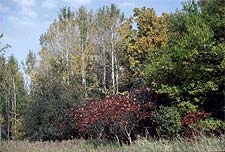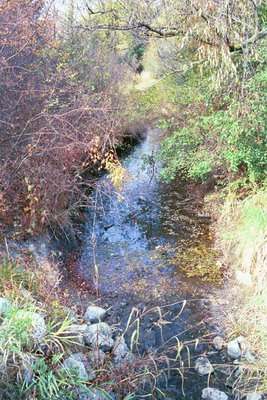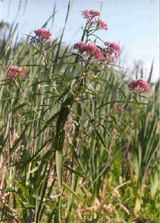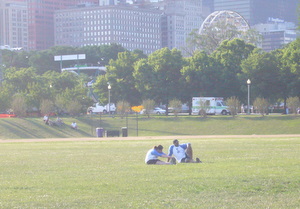
Preserving open lands and creating parkland preserves natural processes of infiltration and limits imperviousness, both of which are intimately linked to stormwater management and water quality. A study from 1993 by the Illinois State Water Survey estimated the value of open space for floodplain storage, including wastewater reclamation, pollution abatement and aquifer recharge as more than $52,000 per acre in the Chicago region (IL Environmental Council, 2007).
As the amount of imperviousness increases in a watershed, the velocity and volume of stormwater runoff increases, which can have several environmental impacts: increased flooding, erosion, and pollutant loads in receiving waters; decreased groundwater recharge and level of water table; altered stream beds and flows; and impaired aquatic habitat. Research has verified the strength of this correlation between the amount of imperviousness in a drainage basin and water quality, with an accepted 10% imperviousness threshold, above which water quality becomes impaired (Schueler, 2000).
There is also a correlation between the location of development, or impervious surfaces, within a watershed and water quality. In a natural landscape, stormwater that isn't infiltrated runs off into waterways, but not without travelling first through vegetated stream banks, thereby being slowed down and filtered. When a watershed is developed, however, stormwater is usually piped through sewer systems and paved drainage ditches. As this occurs, it is funneled together, picking up velocity and pollutants along the way, and emptied in one flush at the end of the pipe, usually directly into a stream. The pollutants flow directly off the road or parking lot, without any opportunity for filtration, and the speed of the water scours the stream bed, causing erosion and often leading to flooding downstream (Brabec, 2002). Riparian buffers can prevent some of these deleterious impacts. By creating buffers around streams and waterbodies, stormwater can be infiltrated, filtered, and slowed before entering waterways. They help allow the hydrological cycle to function more naturally (Lehner et al, 1999).
Researchers have attempted to pinpoint a size or distance threshold at which buffers are most effective, with variable results. The general rule seems to depend on the size of the drainage basin, with larger basins requiring larger buffers (Brabec, 2002). There is evidence to suggest that protection of headwaters has a larger impact because upstream disturbances carry over more stream miles (Maxted and Shaver, 1998).
Preserving open space and creating parks and greenways are key tools to limit imperviousness and create riparian buffers in a watershed. These programs are often the specific means of implementing larger growth management goals, but can also been seen as one of the most cost-effective means for reducing and managing stormwater runoff and protecting water quality (Schueler, 2000). By focusing efforts to preserve and protect open space to those lands around waterways, water quality goals can coincide with growth management goals. These riparian lands are often targeted for open space protection for other reasons – they offer good habitat or are aesthetically appealing – but they help protect water quality as well, serving as buffers for stormwater runoff, or preserving natural infiltration processes. Conversely, efforts to protect water quality can drive land preservation. Municipalities may utilize tools such as down-zoning, open space requirements, conservation subdivisions/design, or transferring development rights in order to improve their water quality, all of which can result in natural lands being preserved.
|
Des Plaines River Corridor
Made up of several Lake County and Cook County Forest Preserves, the Des Plaines River Corridor travels along its namesake river forming a nearly continuous stretch of open space for almost 50 miles. Although the motivations behind protecting the different preserves that make up the corridor are varied, it is clear from the concentration of parks around the river that protecting water quality seems to be a major goal.
|
In more urban areas, where imperviousness is much higher than 10%, parks and open space can also play a role in stormwater management and water quality. They can provide natural infiltration benefits, especially if they are vegetated with mature trees – natural pollution filters. Depending on the species and soil conditions, trees can absorb a considerable amount of water, as well as water-polluting nitrates, phosphorus, and potassium, and keep it out of the flow toward the storm sewer (American Forests website). Furthermore, urban parks can be locations for structural best management practices (BMPs) that assist with stormwater, such as constructed wetlands, detention/retention ponds, or rain gardens. These BMPs help slow and store stormwater, allowing it to slowly infiltrate into the ground or runoff into sewer systems, but at a slower rate, and with some natural filtration (Schueler, 2000). This helps prevent the receiving waterbody from being "shocked" by pollutants or higher temperature runoff after a storm. The traditional method of collecting stormwater runoff transfers the water as efficiently as possible into a system of gutters, sewers, and drainage ditches. A more modern approach is to move water slowly through cities, allowing for on-site infiltration thereby minimizing flooding, and maintaining water quality.
The City of Chicago is very forward-thinking in this approach, currently working to implement a "green alley" system (see Conservation Design strategy report) which would allow rainwater to soak into the ground in the alleyways, subsidizing green roofs throughout the city, among other programs (City of Chicago website). Furthermore, the City has partnered with architecture and engineering firms to investigate the concept of "eco-boulevards," a series of 50 ribbons of open space running across the city, replacing pavement with green space and parks and wetlands, treating waste and storm water (UrbanLab website).
 What could be more "environmentally-friendly" or "green" than preserving parkland and open space? Benefits like improved water quality and air quality, increases in biodiversity and habitat protection, and reductions in greenhouse gases (GHG), are all inherent in a strategy that protects and preserves land. However, the specifics of these environmental benefits, and the mechanisms behind them, are often less obvious. Furthermore, environmental benefits are often difficult to quantify and may not receive as much consideration as those which are easily quantifiable. This section attempts to identify and describe these key environmental effects, as well as the potential drawbacks or challenges of preserving parks and open lands region-wide.
What could be more "environmentally-friendly" or "green" than preserving parkland and open space? Benefits like improved water quality and air quality, increases in biodiversity and habitat protection, and reductions in greenhouse gases (GHG), are all inherent in a strategy that protects and preserves land. However, the specifics of these environmental benefits, and the mechanisms behind them, are often less obvious. Furthermore, environmental benefits are often difficult to quantify and may not receive as much consideration as those which are easily quantifiable. This section attempts to identify and describe these key environmental effects, as well as the potential drawbacks or challenges of preserving parks and open lands region-wide.
 As land is preserved throughout the region, a key environmental benefit is the protection of unique habitat and regional biodiversity. Wildlife and vegetation depend on undisturbed natural areas for food, shelter, and reproduction, often in ways that humans have not always recognized. However, we are beginning to learn about the interconnectedness of the ecosystems of which we are a part, and how it is beneficial for us to protect and preserve habitat and biodiversity within the region.
As land is preserved throughout the region, a key environmental benefit is the protection of unique habitat and regional biodiversity. Wildlife and vegetation depend on undisturbed natural areas for food, shelter, and reproduction, often in ways that humans have not always recognized. However, we are beginning to learn about the interconnectedness of the ecosystems of which we are a part, and how it is beneficial for us to protect and preserve habitat and biodiversity within the region.
